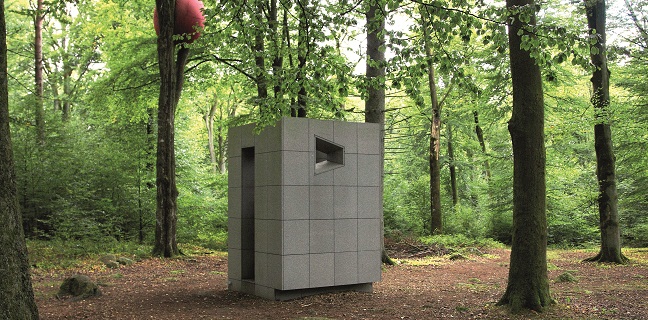
Thom Merrick
(Född/Born 1963, verksam i/works in New York)
Whitney Outhouse of American Art, 1996
Granit från Tossene, hålstensblock/Granite from Tossene, cinder blocks
380 x 235 x 210 cm
Med stöd från/With support from Stenentreprenader i Hessleholm
For English please scroll down
Thom Merricks Whitney Outhouse of American Art är en parafras på den ursprungliga byggnaden som inhyste Whitney Museum of American Art i New York, gjort som ett utedass. Det är en liten variant av den modernistiska byggnaden där museet låg fram till 2014, ritat av Bauhausarkitekten Marcel Breuer 1966. Flera av förlagans karaktäristiska drag finns med: den sneda fönsterutformningen, det indragna bottenpartiet samt fasadplattorna i grå granit.
Whitney Outhouse of American Art är ett lekfullt verk som kan ses som en kommentar till arkitektur med bristande hänsyn till kroppens dimensioner och till människorna som ska använda byggnaderna. Trappstegen som leder upp till utedassets inre är oproportionerligt höga. Detsamma gäller dassets sits. Genom det överdimensionerade formatet ges fullvuxna människor känslan av att vara barn på nytt och det är svårt att ta sig in. När Merrick förlöjligar Whitney Museum genom att gestalta det som ett utedass kan verket också ses som en kritik av konstitutionernas makt och urvalsmekanismer.
Merrick arbetar med ständigt skiftande material och metoder. Återkommande är referenser till konsthistorien och han arbetar ofta med lekfullt och humoristiskt förhållningssätt. Genom sina verk försöker han tillgängliggöra den konstnärliga produktionen samtidigt som han ofta framför en institutionell och samhällelig kritik. Till utställningen på Wanås skapade han också Bad Mood Lamps, elva upplysta bilöverdrag som hängde i taket i Magasinet.
>>>
Thom Merrick’s Whitney Outhouse of American Art is a paraphrase—in the form of an outhouse—of the original building that housed the Whitney Museum of American Art in New York. It is a much smaller variation of the modernist building, designed by the Bauhaus architect Marcel Breuer in 1966, where the museum displayed artworks until 2014. Many characteristic features of the original are included: the slanting window layout, the recessed lower area, and the grey granite facing.
Whitney Outhouse of American Art is a playful work that can be seen as a commentary on architecture that lacks consideration of the dimensions of the human body, and of the people who will use the buildings. The stairs that lead up into the outhouse are disproportionately tall, as is the toilet seat, and full-grown adults are given the feeling of being children again. Though Merrick pokes fun at the Whitney Museum by representing it as an outhouse, the work can also be seen as a criticism of the authority of and selection mechanisms used in art institutions.
Merrick is constantly shifting his materials and methods. References to art history are common in his art, and he often works in a playful and humorous attitude. Through his works, he attempts to make artistic production accessible while often emphasizing institutional or social criticism. For the exhibition at Wanås in 1996 he also created Bad Mood Lamps, eleven illuminated car covers suspended from the ceiling in the Barn.